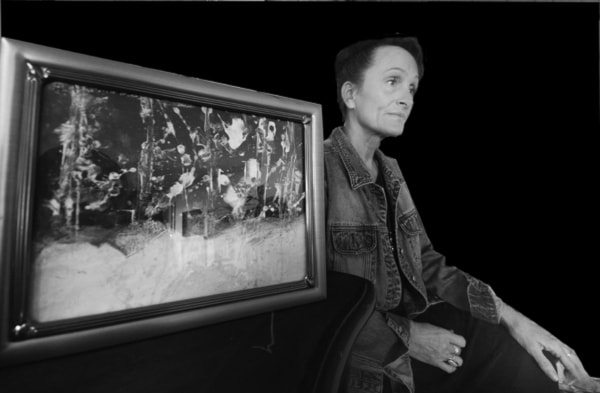 Editors note: This is the final part in a series on mental health leading up to Mental Illness Awareness Week Oct. 5 to 11. Click the link to read A gift taken away and Walking the troubled path.
Editors note: This is the final part in a series on mental health leading up to Mental Illness Awareness Week Oct. 5 to 11. Click the link to read A gift taken away and Walking the troubled path.
What began as a dark splash of anger on a piece of paper for Paula Barton, now has become a window to the deepest reaches of her inner self.
The abstract art work she began a year ago, where she literally throws the paint on the canvas, has helped her cope, and more importantly, understand the mental health issues she has struggled with for over 40 years.
“It’s given me a new lease on life and it’s really starting to make me feel good about myself, I wish everybody could paint just to get that feeling like I’ve had,” said Barton, 56, who has dealt with depression and anxiety for most of her life. “So what I’m feeling, my emotions come out on canvas and what it’s doing is helping me learn about my anger and my depression and my feelings. All the things I’m stuffing inside myself are coming out on the canvas.
“How does that work? I don’t know, I guess by the grace of God, it stumps me.”
Much of what she saw in those early works was not pretty, in fact, it was anything but. However, from those images she recognized the need to explore her feelings to a much greater degree.
What she realized was she needed to develop a method to find answers to questions which past treatment, medication and otherwise, only masked.
“One of my first pieces, and I was very angry when I did it, when I put it on my desk and looked at it, there was the devil, really, really clear,” she recalled. “I mean this is just abstract but the devil came out and I went wow, because I didn’t realize I was that angry,” she said. “I put that one away because I couldn’t handle looking at it but a girlfriend just kept making me pull it out. Now almost every time I walk by it I see something different and I can’t explain that.”
 But even that work, which now sits framed on the desk in her living room, has helped her manage all the demons which still stop by.
But even that work, which now sits framed on the desk in her living room, has helped her manage all the demons which still stop by.
Increasingly, and much to Barton’s delight, she is making more visits to happier acrylic places.
Although she has no formal training and is not artistically fluent in colours, she sees within the pinks and purples — spring and summer colours she calls them — images of birds and bicycles.
“That’s a good thing, because if it was nothing but doom and gloom I’d have to be committed,” she said with a laugh. “With depression it’s up and down and my paintings are like that. It’s very reflective of who I am.”
There have been some added benefits to moving into the world of art for Barton. That includes leaving her largely isolated world more often and interacting with other people.
“I’ve even got a piece in the show at the (Penticton Art) Gallery which is really neat,” she said
The seventh annual psychiatric show Beyond Words: How does my garden grow, began last month and runs until the end of October.
Her contribution is a small piece in which she sees herself crying tears of blood as the grim reaper stands at her side.
“Really this just represents what the power of depression can do to you and the thoughts of suicide and other things that come into your head,” said Barton. “But being able to do this work helps get those feelings out in the open and it’s not so bad.”
While the power of art has been an incredible revelation to Barton, to Sharon Evans, president of the B.C. Schizophrenia Society in Penticton, art has long been recognized as a very important tool in to whatever degree possible, self healing.
“As a therapeutic tool, it permits them to express things that they can’t put into words,” said Evans, a longtime psychiatric nurse. “For some people, it’s a way of expressing their experience with psychosis, which is a detachment from reality, or it’s a way of expressing the difference between when you’re depressed and when you’re not depressed.
“For other people, it’s just an outlet, because we all need, as human beings, to be creative in some way, shape or form.”
And much like Barton herself, her art is a work in progress. But each day it gives her the strength to climb out of bed, even on those gloomy mornings, open that window and let the sun shine in.
